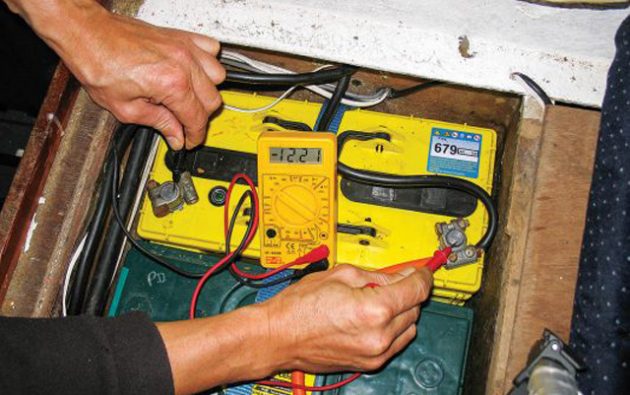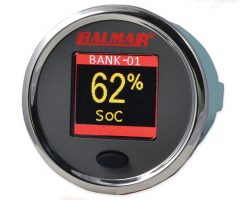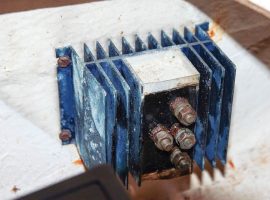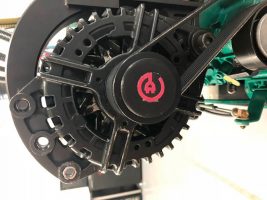Rupert Holmes on the importance of battery maintenance for boat owners: why you should look after your boat batteries and what you can do to make boat batteries last longer
For all but the smallest and simplest of craft a reliable supply of battery power is essential to keep both vital safety systems and domestic comforts running. They’re therefore an integral part of a boat’s reliability and resilience.
Looking after batteries also makes good financial sense – if treated badly they can fail within a couple of seasons, but if well maintained may last for six to eight years.
So what does taking care of boat batteries involve?
The most important factor is to avoid deep discharges – discharging below 50% of total capacity significantly reduces battery life. And flattening them completely is extremely detrimental.
In addition, it gets progressively harder to charge batteries beyond 80% of their full capacity. Yet failing to fully charge batteries, at least occasionally, also shortens their life. More on this later.
Finally, even if left disconnected, the state of charge declines by around 1-3% per month. This means batteries also benefit from being periodically charged over the winter, even if the boat isn’t used.
Battery monitoring
I’m repeatedly surprised by the number of boats I encounter that have no effective means of monitoring battery charge.
Many older craft have analogue voltmeters, but those with a typical 0-15V scale are next to useless as we’re most interested in fine graduations within the 12-13V range. These give a good indication of a battery’s state of charge, providing it has been resting for some time.
Remaining Charge
12.9-13.2V = full charge
12.6V = 75% charge
12.2V = 50% charge
12.0V = 20% charge
11.8V = battery flat
Even if a battery has not been resting for several hours its voltage will still give a useful rough indication of its remaining charge (see table above). And a digital multimeter to check this can be bought for under £10.
Those who are happy to spend more and, crucially, are prepared to spend time on calibration will benefit from a properly configured battery monitor. These account for all factors that affect battery state, calculating the total charge delivered to the batteries, and subtracting the total used by the boat’s systems.
However, if they are not periodically recalibrated to reflect the progressive decline of a battery bank’s capacity they will give a falsely optimistic view of the state of charge.
Battery health
Neither a simple voltage reading, nor a standard battery monitor, will tell you whether batteries are nearing the end of their useful lifespan. The traditional test for this is to connect a constant low load over an extended period of time, while measuring the declining state of charge. For instance a constant 2.5A load over 20 hours would draw a total of 50Ah from the battery, so half the rated capacity of a 100Ah unit.
Of course in the real world it’s not quite so simple – as battery voltage falls the power drawn by a simple load like a lightbulb falls. Though even a rough test of this type can quickly reveal a battery that will only accept 50% or 60% of its original rated charge.
An alternative is Balmar’s recently launched SG200 battery monitor, which automatically calculates the real-life capacity of battery banks and displays this as ‘State of Health’, presented as a percentage of the batteries’ original rated capacity.
Basic charging systems
Most of us still rely on an engine-driven alternator to produce much of the 12V electrical power needed on board. This makes sense in many ways, given the output is as good as free when the engine is running. However, many arrangements are inefficient, particularly those that were installed as standard on boats more than 15-20 years old. This is particularly true if two or more battery banks are charged via split charge diodes.
It’s clearly important to have a good understanding of the configuration on your boat and its inherent pros and cons. It’s good practice to have two battery banks, so that one can be reserved solely for engine starting, while the other is used for domestic loads, lights, electronics and so on. Some vessels may have a third bank for a windlass, bow thruster or other high-power devices.
Each bank may comprise of just a single battery, or of several batteries connected in parallel. In larger yachts with 24V electrics batteries are connected in series to double the system’s voltage.
Split charge diodes are simple technology that allows more than one battery bank to be charged without need for any manual switching. However, there’s a voltage drop of around 0.7V across the diode, which saps a significant amount of power before it ever reaches the batteries.
There are three potential solutions to this problem. One is simply to adjust the output from the alternator to a higher voltage, but in practice that may not be possible without adding extra gear.
Another option is to add a rotary ‘0-1-2-both’ style battery switch and manually change between each bank when the engine is turned on and off. In many ways this is the simplest and often cheapest arrangement, but introduces the risk of user error that could result in the engine start battery being discharged by domestic loads.
However, best practice for managing multiple battery banks is to use voltage sensitive relays (VSRs). These automatically switch the correct battery banks in and out of use, without human intervention and without the voltage drops associated with diodes. They are well-proven technology that have now been used in the marine and automotive worlds for a long time and are sold by chandlers at prices from around £75.
A real-life example
Back in 2001, when I bought Ammos, my 30ft Discovery 3000 in Greece, she was fitted with split charge diodes. I persevered with that system for a long time, even though the service batteries sometimes only lasted around three years. With hindsight I should have updated the charging system earlier.
As LED lighting dropped in price in the mid to late 2000s I replaced all the bulbs, which dramatically reduced power requirements. Equally, as solar became more affordable I fitted a panel on the main hatch garage, which all but eliminated the need to use the engine for charging.
I carried out a bigger upgrade of the system when the batteries needed to be replaced in 2012, finally getting rid of the split charge diodes and the next battery bank lasted for seven years.
When they needed replacing last year I again looked at the recent changes to affordable technology and added more solar power and updated the charge controller. As a result I’m hoping the new batteries will last even longer than their predecessors.
The final 20%
While replacing split charge diodes will improve charging, it’s not the end of the story. Standard alternators tend to only provide a high rate of charge for the first 20 to 30 minutes of engine running, after which it rapidly declines to a relatively small fraction of the alternator’s rated output.
Worse still, although lead acid batteries will fairly readily accept the first 80% of their rated charge, the final 20% is a different matter and it becomes progressively harder to pump additional power into the batteries as their state of charge rises towards 100%.
This matters for two reasons. Given lead acid batteries don’t like discharge below 50% of total capacity, if they are never charged above 80% then less than one-third of the total capacity is available for use.
Even worse, batteries using any kind of lead-acid technology have a memory effect where, if they never receive a full charge, it becomes progressively more difficult to achieve a state of charge above 80% of the original capacity. This tendency will continue over the life of the battery, with the available capacity continuing to decline.
For boats that live in marinas with access to shore power a three or four-stage battery charger will also ensure batteries get to be fully charged. Some units also have an ‘equalisation’ function that increases voltage for a period with the aim of reducing the amount of sulphation that builds up on the plates over time. This can be particularly helpful for batteries that can be topped up with distilled water.
However, for sealed types, including AGM and gel batteries, it may result in premature gassing and therefore depletion of the available electrolyte. It’s also possible to get solar power controllers that offer similar benefits – these can be a good solution for boats that are kept on moorings with no access to shore power.
A three or four-stage smart regulator for the alternator will speed up both the bulk-charging stage when motoring for an extended period and will also significantly raise the rate of charge once batteries are more than 80% full. Before fitting one, it’s also worth checking whether there’s a larger alternator available for your engine. In some cases it can cost under £100 to upgrade from a 55A unit to a 75A one, which is a worthwhile improvement at a modest cost.
Solar power
Although a diesel engine will provide virtually free power when the boat is underway under power, this is often far from the case if it has to be started solely to charge batteries. To do so invites accelerated engine wear, especially if it’s not run under load, and in any case this is a very inefficient way to covert fossil fuel into electrical energy.
This is a key factor behind the popularity of solar panels. Even a simple installation with a 50-100W panel on the coachroof can be a game changer and prices are continuing to drop dramatically.
A controller or regulator is needed to prevent batteries overcharging. These come in different types: a PWM (Pulse Width Modulation) controller is a basic type that controls the voltage output, but may still have a three-stage charging regime that packs the final 20% of charge into the batteries, before switching to maintain a safe float charge.
MPPT (Maximum Power Point Tracking) charge controllers optimise the voltage and current outputs from the panels so that they pump out the maximum possible power for the prevailing conditions. MPPT controllers are particularly good when a number of panels are connected in series to give higher voltages in the 30-50V range.
Although many boats benefit from solar power it’s worth bearing in mind that it doesn’t automatically make sense for every vessel. There’s a strong argument that solar is unnecessary for boats that are kept in a marina with access to mains electricity and which are primarily used only for weekend trips.
However, the longer the boat ventures away from the national grid, the greater the benefits of increased electrical self-sufficiency. In many cases the cost of a simple solar installation will be repaid in greater battery life.
Minimising consumption
An undersized domestic battery bank is a certain route to premature battery failure. Ideally total daily consumption, measured in amp-hours, should be no larger than 30% of the rated capacity of the domestic battery bank.
It’s worth analysing whether onboard power consumption can be reduced without compromising on comfort and convenience.
Changing to LED lighting, if not done already, is an obvious easy gain that can reduce the power used for lighting by 90%. As is ensuring the fridge is properly insulated – ideally it should have 10cm (4in) of insulation – and good airflow around the compressor will also increase efficiency.
If you use laptops on board, rather than tablets, it’s worth bearing in mind that many of the recent developments in processors have focussed on reducing power consumption, so newer models tend to be noticeably less power hungry.
Other charging inputs: wind generators, hydro generators and fuel cells
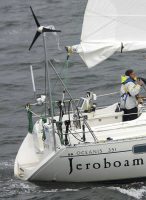 Having installed a mains charger, coachroof mounted solar and smart alternator regulator, if you still need more charging inputs the options tend to be more expensive. They will also vary depending on the way the boat is used.
Having installed a mains charger, coachroof mounted solar and smart alternator regulator, if you still need more charging inputs the options tend to be more expensive. They will also vary depending on the way the boat is used.
Before the price of solar started to fall dramatically wind generators were often the first choice.
However, nicely sheltered harbours and anchorages generally have good protection from strong winds, and most cruisers try to choose downwind or reaching conditions for passage making, which means the apparent wind may not be very high. Therefore wind generators often produce a lot less power than expected.
A hydrogenerator, whether an old school model with a towed impeller or a contemporary transom-mounted device, makes a lot of sense for long-distance passagemaking and has the potential to provide more than enough power to run all systems while at sea.
Methanol fuel cells are a favourite of the long-distance racing community, especially on short-handed boats. However, they are relatively expensive to run and have a service life of around 5,000 hours, which makes them much less appealing to cruisers.
An additional source of hydro-generation is available to boats with electric propulsion that are set up for re-generation. This uses the propeller as a turbine and the electric motor as a powerful alternator to rapidly charge large battery banks while the boat is under sail.
It’s an appealing idea to know that you could be generating the power while sailing in an afternoon sea breeze to motor for several hours later on after the wind dies.
The increasing affordability of other forms of charging now means that generators powered by internal combustion motors have mostly become the preserve of larger and more complex yachts that have significant power requirements, especially if they run air conditioning while at anchor.
The advent of the Integrel system (see below) makes the case for installing a diesel generator on many boats even weaker.
Integrel ‘smart’ alternator
This Cornish company has taken the concept of extracting charge from the power that’s (almost) freely available while a propulsion engine is running to its logical conclusion. The Integrel system consists of an extremely powerful alternator controlled by smart electronics that places more load on the engine when it’s running at speeds below maximum efficiency. For more info, see: integrelsolutions.com
Replacing batteries
I’ve deliberately left this section to last, as simply substituting like with like in an outdated and underspecified system is an invitation to early failure of the new batteries. Instead it’s worth taking the opportunity to assess all aspects of the charging systems and the loads to see whether useful efficiencies can be made. This is an approach that will maximise the lifespan of the new batteries – regardless of their price point – and improve the boat’s reliability.
If there’s more than one battery in a bank then it’s good practice and usually more cost-effective in the long term to replace all of them simultaneously with identical units from the same source.
Automotive batteries are designed to provide short high-energy bursts to starter motors, but are unsuitable for running other systems, which may have a small but sustained power draw over many hours.
Leisure batteries have thicker plates and are better for this type of slow discharge, with some of the best rated to around 400-500 50% discharge cycles.
Traction batteries have extra thick plates and are therefore much heavier, but may withstand around 1,000 partial charge-discharge cycles. The relationship between thicker plates and longevity means, in the absence of other data, weight can sometimes be used as a rough proxy for the quality of deep cycle lead acid batteries.
AGM and gel types cannot spill battery acid, don’t produce potentially explosive hydrogen gas when charging and have potential to withstand more charge-discharge cycles. Prices are trending downwards, making them an easier choice for use on board.
AGMs also have the benefit of being suitable for both starting and deep cycling, while also accepting charge more quickly than standard wet lead acid batteries.
Historically lithium-ion batteries have been prohibitively expensive, but are now becoming rapidly more affordable, especially when the long-term costs of ownership are considered.
It’s important to recognise they need different charging regimes, and sophisticated battery management is needed to maintain safety. Therefore, other elements of the electrical system are likely to need replacing before lithium batteries can be fitted.




